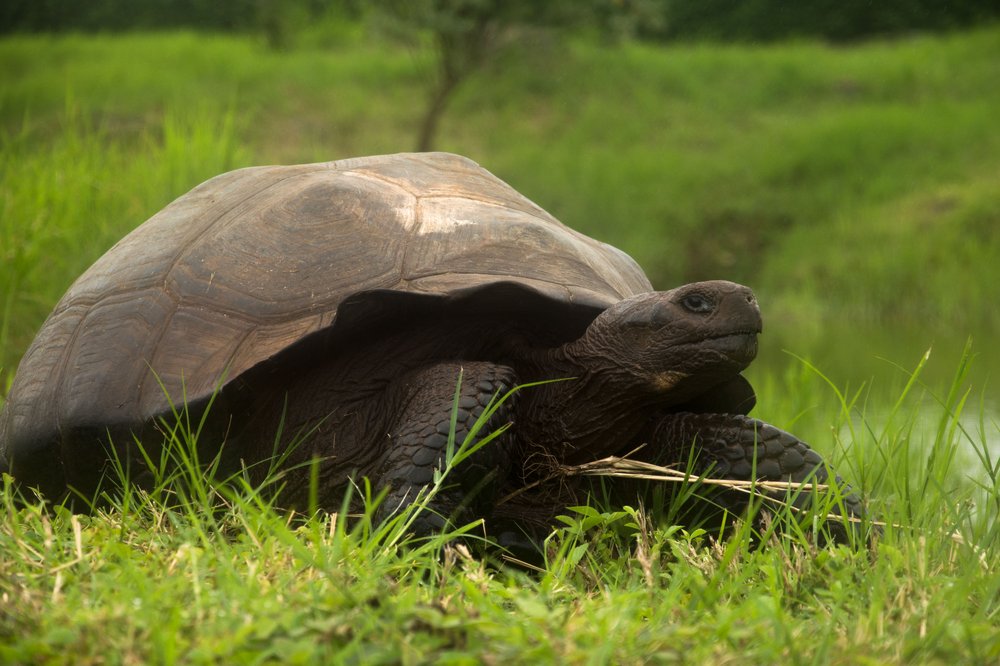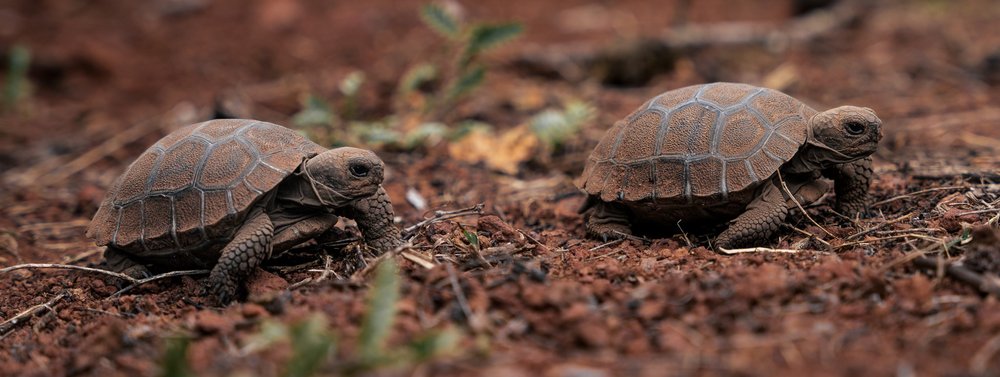New Studies Offer Critical Insights into Conservation of Galapagos Giant Tortoises on Santa Cruz Island
Invasive Cedrela tree poses risk to giant tortoise migration
Environmental variation shapes tortoise reproduction and survival
Two groundbreaking studies led by Stephen Blake, Ph.D., assistant professor of biology at Saint Louis University and Sharon L. Deem, DVM, Director of Saint Louis Zoo Institute for Conservation Medicine, in collaboration with the Charles Darwin Foundation (CDF) and teams of multidisciplinary scientists shed light on crucial aspects of the conservation of two critically endangered giant tortoise species endemic to the Island of Santa Cruz, Chelonoidis porteri and Chelonoidis donfaustoi. Both studies offer valuable insights into the challenges these emblematic species face and the strategies needed to ensure their survival in the face of potential future habitat alteration and climate change.
Invasive Cedrela tree poses risk to giant tortoise migration
Published in the latest issue of Ecology and Evolution, this recent study sheds light on the influence of the invasive tree Cedrela odorata, commonly known as Cedrela, on the migratory patterns of the Western Santa Cruz Galapagos tortoises, Chelonoidis porteri.
The study utilized GPS telemetry to track 140 migratory journeys by 25 Galapagos tortoises over a period of 12 years. During the dry season, giant tortoises migrate up the hills to greener pastures, which is when they encounter dense stands of the invasive Cedrela tree. Researchers observed a clear avoidance pattern of Cedrela forest by the tortoises, with migrations overwhelmingly restricted to three small corridors between blocks of Cedrela forest. These corridors varied between 1.18km wide at their largest point and 140m wide at the narrowest. Only 12 of 140 migrations traversed extensive Cedrela stands, indicating a significant disruption to the tortoises' natural habitat and migratory pathways.
Dr. Stephen Blake, lead author of the study and longtime CDF-collaborating scientist, notes: “Giant tortoises play a crucial role in the Galapagos ecosystem as seed dispersers and nutrient recyclers as they trample the ground on their migratory journey up and down the hill, thereby shaping habitats far and wide. The fact that they are avoiding entire patches of land invaded with Cedrela, which they did not use to encounter on their migratory journey, could pose a real threat to the health of habitats on Santa Cruz Island, and to the ability of tortoises to find sufficient food to maintain their energy balance.”
Cedrela odorata, known for its rapid growth, was introduced into highland farms on Santa Cruz during the 1940s. It has since expanded beyond the agricultural areas and into areas of the Galapagos National Park, posing challenges to native vegetation. Cedrela is renowned for its high-quality timber around the world and plays an important role in the Galapagos local economy as it’s the only source of local timber, used for construction, furniture and handicrafts.

Dr Rakan Zahawi, co-author of the study and CDF Executive Director, comments: “While highly invasive in Galapagos and other Pacific Islands, Cedrela is listed as Vulnerable on the IUCN Red List as it has been overharvested in its native range, including continental South America. It’s an interesting conservation conundrum that Galapagos is facing as, on the one hand, Cedrela thrives here and is useful to the local economy, and on the other hand it poses a real threat to giant tortoises and other local biota.”
Cedrela has biological and ecological traits that make it a highly successful invader and is currently one of the most widely distributed invasive trees in Galapagos. Besides Santa Cruz Island, Cedrela is found in abundance along the flanks of the volcanoes of southern Isabela Island, and in patches on the Islands of Santiago and San Cristobal – all of which have their own endemic species of migratory giant tortoises.
The study concludes with high-level recommendations for local management authorities, including revising the local legal framework, establishing an integrated research agenda, and convening expert workshops to prioritize conservation actions.
Environmental variation shapes giant tortoise reproduction and survival
A second comprehensive decade-long study published in the scientific journal Ecological Monographs has unveiled critical insights into the reproductive ecology of Galapagos giant tortoises, shedding light on the impact of environmental variation on their reproduction and survival. The research focuses on Santa Cruz Island’s two critically endangered giant tortoise species, Chelonoidis porteri and Chelonoidis donfaustoi, exploring the intricate biology of these iconic creatures and addressing the role of the environment in shaping how they live.
Migratory and long-lived, Galapagos tortoises face numerous challenges, including anthropogenic threats, and their cryptic early life stages result in many unknowns. This research took a multi-faceted approach, involving the measurement of body and reproductive characteristics of 166 adult females, tracking 33 adult females using GPS technology, and recording nest temperatures and assessing egg survival from 107 nests. Additionally, radio telemetry was employed to monitor the growth, survival, and movements of 104 hatchlings.
One of the study’s key findings is that differences in environmental conditions affect important aspects of the tortoises' lives, such as how many eggs the females produce and how many eggs and hatchlings survive. Some adult females migrate between lower and higher elevations, while others stay in low elevation areas year-round. The study also found that tortoises that migrate have overall better health, as assessed via body condition (the mass of an individual relative to its body length). Nests are found in the hottest, driest lowland areas between 6 and 165 meters above sea level and hatchlings survival is highest at middle elevations.
Dr Stephen Blake, lead author of the study, said: “This second study suggests that future changes in climate could affect tortoises’ reproductive success. To ensure the resilience of these critically endangered species, it’s hugely important that we make sure they can move between places where they eat and reproduce at different elevations, both under current conditions and under possible future climate change scenarios.”
This new research, using a holistic One Health approach to understand environmental factors, tortoise ecology, reproductive fitness, and health status, provides valuable insights into the complex interplay between environmental variation and the biology of Galapagos giant tortoises. Ultimately, these findings contribute to a broader understanding of the early and most vulnerable life stages of these long-lived and important members of the Galapagos ecosystem.

Dr. Sharon L. Deem, senior author of the study said: “Our long-term study, with 10 years of data on environmental conditions, tortoise movement, reproductive fitness, and health, offers valuable information for understanding how we may best ensure Galapagos giant tortoises thrive in the Galapagos while addressing anthropogenic challenges they face in the 21st century.”
In addition to these 2024 publications, last year, research led by Dr. Deem, in collaboration with CDF, found that the elevation at which a female lays her eggs determines the sex of her offspring, suggesting that ongoing global climate change is likely to play an important role in determining the reproductive output of Galapagos tortoises, and the resulting sex ratios of the population.
Implications for future conservation actions
Both studies published this month offer essential guidance for effective conservation efforts, emphasizing the importance of interdisciplinary research and international collaboration in safeguarding the iconic and critically endangered Galapagos giant tortoises of Santa Cruz Island.
"Both studies were the result of years of arduous and meticulous work in the field and further underscore the importance of understanding the movement patterns and lifecycle of these gentle giants, as well as their interactions with their changing surrounding, including invasive species," adds Stephen Blake. "By identifying patterns of habitat use, we can better inform targeted conservation efforts to protect the biodiversity of the Galapagos Islands.”
For media, please contact:
Charles Darwin Foundation
Ambre Tanty-Lamothe / Leslie León
About the Charles Darwin Foundation
The Charles Darwin Foundation for the Galapagos Islands (CDF) is an international nonprofit that has been present in Galapagos since 1959, operating under a special agreement with the Government of Ecuador. Its mission, and that of its Research Station, is to tackle the greatest threats and challenges to Galapagos through scientific research and conservation action, in order to safeguard one of the world’s most important natural treasures. At present, CDF manages over 25 research and conservation projects and is the custodian of more than 135,000 specimens within its Natural History Collections. Our diverse workforce of over 140 individuals is primarily composed of Ecuadorian citizens, with over 60% hailing from the Galapagos Islands. For more information visit: www.darwinfoundation.org





